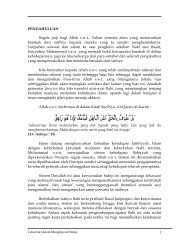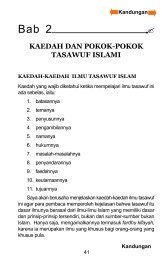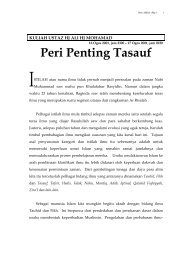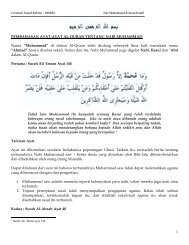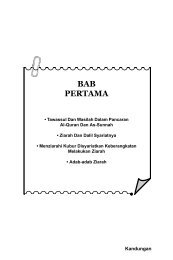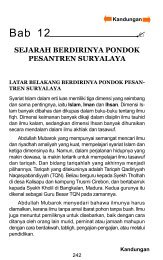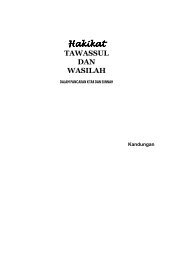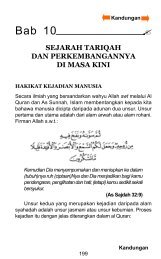You also want an ePaper? Increase the reach of your titles
YUMPU automatically turns print PDFs into web optimized ePapers that Google loves.
JihadIDEOLOGY - not poverty or illiteracy - is thekey driver of Islamist terrorism. Ideologyframes a terrorist group’s organizationalstructure, leadership and membershipmotivation, recruitment and support, andstrategies and tactics. To counter the threatposed by a terrorist group, its operationalinfrastructure must be dismantled and itsideological appeal must be reduced. Failure todo so will result in the group replenishing itshuman losses and material resources and risingagain only to continue the fight.One example of this is AI-Jama’ah AI-Islamiyah (Jama’ah Islamiyah-JI), the SoutheastAsian associate of Al Qaeda. JI has evolvedthrough three phases. In the first phase, thepredecessor of JI, Darul Islam (DI), campaignedfor an Islamic state in Indonesia, and attackedseveral local Indonesian targets. After the DIleadership was forced to relocate from Indonesiato Malaysia, it came into contact with otherforeign <strong>jihad</strong> groups. In the second phase, JIwas transformed into a regional <strong>jihad</strong> group,and carried out attacks throughout SoutheastAsia to advance its original mission. Later, afterparticipating in the multinational anti-Soviet<strong>jihad</strong> in Afghanistan, JI came into contact withAl Qaeda. In the third phase of development, JIcame to share Al Qaeda’s global vision of <strong>jihad</strong>,and began to directly target the U.S., its alliesand its friends either in partnership with AlQaeda or by acting alone.During each of these phases, JI ideologyexhibited a remarkable ability to adapt itself tochanging circumstances, to incorporate newideas, and to apply itself to new strategic andpolitical ends. At the same time, JI ideologyremained firmly rooted in its founding preceptsand extremist political vision of the world. This,in turn, provided JI with a surprising level ofideological and organizational cohesion, evenas it evolved from a local to a global <strong>jihad</strong> group.The Birth of JIJI’S roots can be traced back to theIndonesian rebellion in the 1950s led by DarulIslam (DI). At its founding, the DI movementopposed the secular nature of the Sukarnoregime, and from 1948 to 1962, fought theregime to establish an Islamic state in its place.Motivated primarily by politics, the DI rebellionin West Java was led by Sekarmadji MaridjanKartosuwirjo. Before the Second World War,Kartosuwirjo was active in Muslim nationalistpolitics in the then Dutch East Indies. Heeventually grew unhappy with the politicalmaneuvering and slow-pace of nationalistleaders like Masyumi, and, in 1947 beganassembling a militia in West Java.In 1948, Kartosuwirjo announced theestablishment of the Islamic Army of Indonesia(Tentera Islam Indonesia- TII) and proceededto fight the newly formed Indonesian republic.For the next thirteen years he continued hisstruggle to establish an Islamic state. WhenKartosuwirjo was arrested in 1962, the rebellionwas finally crushed. However, when Suhartocame to power in 1966, General Ali Moertoporeactivated DI to protect Indonesia against thedanger of Communist infiltration across theIndonesian-Malaysian border in Borneo. Inorder to discredit the Islamists before the 1977elections, some 185 people believed to bemembers of Komando Jihad, a group sharingKartosuwirjo’s ideals, were arrested by thegovernment in mid-1977.The founders of JI, Abdullah Sungkar andAbu Bakar Ba’asyir, were among thosedetained by the government. Both of them weredeeply involved in Islamic proselytizing(dakwah) activities. Although they were nevera part of the original Darul Islam, they fullyendorsed DI’s political agenda. Due to theirmeetings with Haji Ismail Pranoto (Hispran forshort), who was accused of leading theKomando Jihad, they were both charged withhaving been inducted into DI by Hispran.Whatever the truth of the charges was, it is nosecret that both of them were known for makingstatements urging disobedience to secularauthorities and questioning the validity of theIndonesian constitution. Sungkar and Ba’asyirrejected the state ideology of Pancasila, anddared to criticize the Suharto government. Theywere tried in 1982 and sentenced to nine yearsin prison for subversion. Subsequently, theirsentences were reduced on appeal to threeyears and ten months. Facing imminent rearrest,they fled to Malaysia. In exile, Sungkarbecame the Suharto regime’s number oneenemy.In Malaysia, Sungkar identified a number ofsympathetic Malaysian businessmen whosupported the establishment of an Islamic statein Indonesia. In an effort to seek additionalfunding for their cause, Sungkar and Ba’asyirwent to Saudi Arabia. They also establishedcontacts with the mujahideen in Afghanistan,who were then waging war against the SovietMasjid <strong>Khadijah</strong> 29



